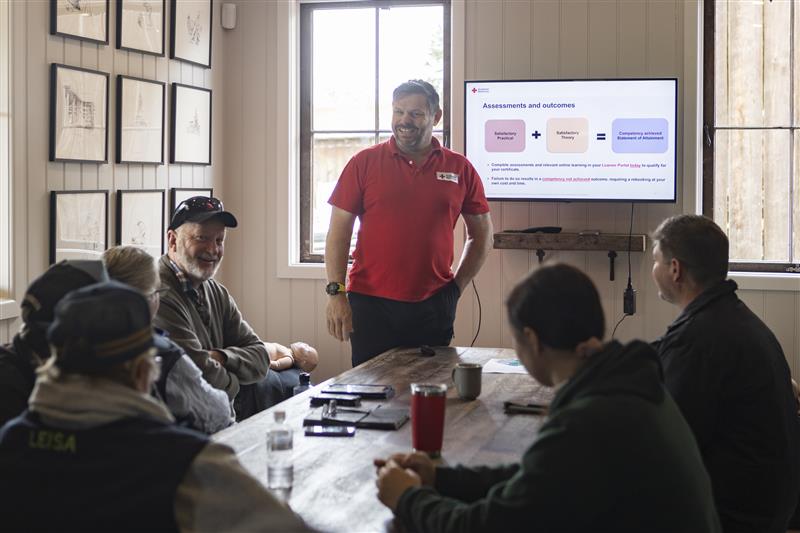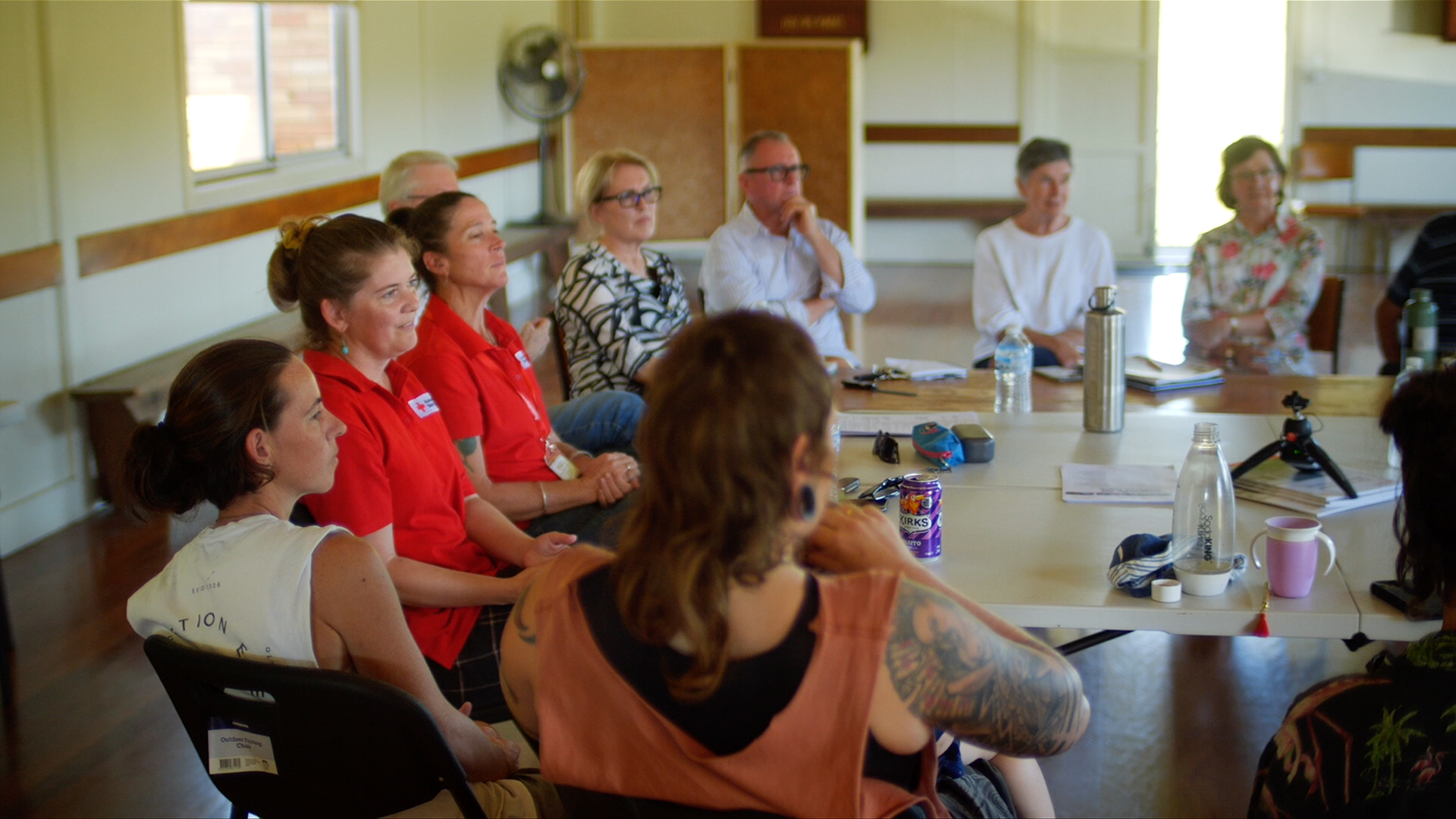Stronger together
How Community-led Resilience Teams are changing the way communities prepare for disasters.

Disasters are becoming more frequent and, due to our changing climate, more widespread and severe. When disaster strikes, it’s often the people around us – our neighbours, friends and local businesses –who are first on the scene. In moments like these, the strength of a community can make all the difference.
Community-led Resilience Teams (CRTs) are a practical, grassroots way for communities to prepare for, respond to, and recover from emergencies – together. Born out of the need for stronger local connections following devastating floods in Northern New South Wales after Tropical Cyclone Debbie in 2017, the CRT model has since taken root in more than 100 communities across Australia, with support and guidance from Australian Red Cross.
What is a Community-led Resilience Team?
A Community-led Resilience Team (CRT) is an ‘all-hazards’ approach to preparing for emergencies, designed by Australian Red Cross for communities, so they can connect and prepare for disaster together. CRTs do this by establishing a local communication network to activate during emergencies, while identifying the best ways to support each other throughout the recovery journey.
What sets CRTs apart is that they are led by the community, for the community – because locals know the needs of their communities best. With support from Australian Red Cross and other services, households, businesses and volunteers come together to create a local network, build preparedness plans, and stay connected through simple communication channels like social media, phone trees and even UHF radio networks. Each community shapes their CRT in a way that works best for them.
These networks become vital lifelines in times of crisis; they allow residents to share timely information, check in on neighbours, and coordinate local responses. Just as importantly, CRTs create space for communities to support one another after emergencies, sharing resources and looking after each other’s wellbeing.
Australian Red Cross supports CRTs with training and events designed to empower local leaders and residents with practical knowledge and skills. From First Aid and psychological support to emergency communications, scenario exercises and disaster preparation-focused Pillowcase workshops for kids, these offerings help communities to feel more confident and capable, no matter what kind of emergency comes their way.
The power of business in resilience
The CRT model is also proving valuable for local businesses. In places like Lismore, neighbouring business owners formed their own resilience networks to plan for floods, support one another’s recovery, and access tailored preparedness training from Australian Red Cross, Service NSW and local chambers of commerce.
From breakfast workshops to shared flood plan templates, these business CRTs are helping communities build a more resilient local economy – because when businesses bounce back, so do jobs, livelihoods and services.

How can a Community-led Resilience Team help my community?
Is your household or business prepared for an emergency? Do you have a plan in place? Would you know when to evacuate, where to go, or how to stay connected when disaster strikes?
Community-led Resilience Teams (CRTs) are a practical and powerful way to strengthen local preparedness and recovery. They bring people together to plan, connect and build confidence before an emergency happens,so that when it does, your community is ready.
Australian Red Cross staff and volunteers can deliver a range of resilience and recovery training to communities who would like to establish a CRT. This could include:
- Community-led Resilience Team training
- Street Coordinator training
- Introduction to emergency management arrangements with other emergency services
- Mapping local disaster risks
- First Aid training
- EmergencyREDI household preparedness training
- Business emergency preparedness training
- Emergency communication training and testing days
- Tales as Old as Time community connection events
- Understanding Psychological First Aid training
- Recovery Basics, Sleep and Wellbeing Workshops
- Cuppa and a Chat events
- Pillowcase workshops to help primary school aged children to prepare for emergencies
- Community engagement events, such as Get Ready Days and gatherings
- Redi to Adapt emergency scenario-based workshops to practice what might happen in an emergency.
CRT stories of success
Bulga – Singleton Council, NSW
The Bulga Community-led Resilience Team (CRT) links the communities of Bulga, Milbrodale and Fordwich in the Upper Hunter Valley in NSW. The CRT formed after the 2019/20 bushfires and has become a local hub for information and support through recent flood and bushfire events. As for other CRTs, the Bulga CRT operates on a voluntary basis, with each member contributing in a way that suits them best – whether as a Designated Communications Volunteer, a member of the Bulga CRT Commitee, or by using their local time local knowledge to support the community’s understanding of risks, like Frank’s Flood Meter. In this video, CRT leader Kristy Hedley tells the story of her community’s CRT.
Video courtesy of Rural Adversity Mental Health Program (RAMHP).
Malabugilmah – Clarence Valley LGA, NSW
In Malabugilmah, a small community in the Clarence Valley region of NSW, CRTs emerged after bushfires tore through the area in 2019 and 2020. So they could be better prepared the next time a disaster struck, the community worked with Australian Red Cross to build new skills, develop a communication network, and strengthen their connection with local emergency services. Today, the Malabugilmah CRT plays a key role in helping residents feel more connected and supported through emergencies and recovery.
Rock Valley – Lismore LGA, NSW
In Rock Valley, just outside of Lismore, residents came together in early 2025 to form their CRT after a string of flooding and landslip events. Less than a month after completing emergency communications training with Australian Red Cross, Tropical Cyclone Alfred hit. Thanks to their newly formed network and skills, community members were able to support one another and even save a life.
Minyon Resilience Network – Byron Shire, NSW
Meanwhile, the Minyon Resilience Network – a CRT that brings together the communities of Coopers Creek, Repentance Creek and Rosebank, also in the Northern Rivers region of NSW – has grown into a vibrant local movement. Supported through the Northern Rivers Recovery and Resilience Program, Australian Red Cross has worked with the CRT to deliver First Aid and emergency training, while bringing people together through community events like a Christmas pizza party and sausage sizzles. It's a reminder that resilience isn’t just about preparing for the worst – it’s also about bringing communities together and celebrating what we share.
Ewingar – Clarence Valley LGA, NSW
Ewingar is a remote community in Northern New South Wales. In recent years, it’s been hit by successive disaster events, including bushfires and floods. The community was significantly affected by the 2019 Long Gully bushfire, which claimed lives and caused extensive property loss and damage in Ewingar and surrounding communities. Here, local Ewingar CRT members Geoff and Alexey take part in an Australian Red Cross emergency communications mapping test, while sharing how Australian Red Cross and Clarence Valley Council CRT support has helped their community to feel more connected and better prepared for disaster.
Numulgi – Lismore LGA, NSW
Numulgi is a small rural community made up largely of primary producers and rural landholders, many of whom have lived in the area for generations. Following successive floods and isolation, in 2024 and 2025, Australian Red Cros worked with the local community hall – Numulgi’s vibrant, bustling hub – to deliver events that focus on disaster preparedness and greater community connection, such as a Farmers’ Night Out and Tales as Old as Time, while facilitating First Aid and Understanding Psychological First Aid training days. The locals’ favourite? A Family Fun Day with music, face painting, an alpaca and Shorty the Clown.
Whether you’re a local community member, a parent, a business owner or community group – or just someone who wants to be better prepared – there’s a place for you in a Community-led Resilience Team. By coming together, we can strengthen our connections, share our knowledge, and build the kind of resilience that carries us through disasters as safely as possible.
Red Cross pays our respects to the Aboriginal and Torres Strait Islander custodians of the country where we work, and to Elders, past, present and emerging.
Learn about our Reconciliation Action Plan and how we can all make reconciliation real.
This website may contain the images, voices or names of people who have passed away.
